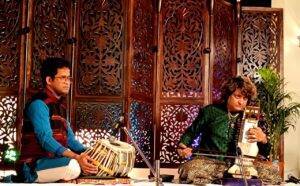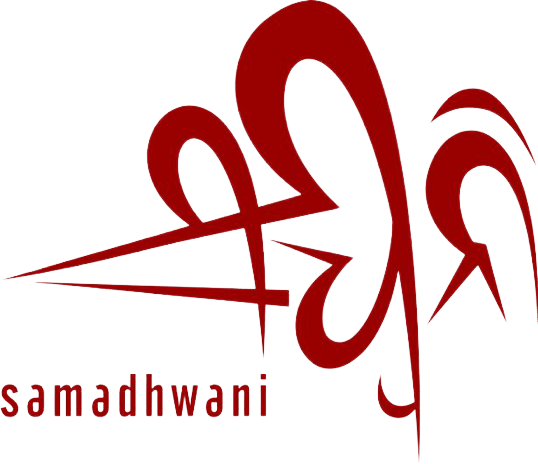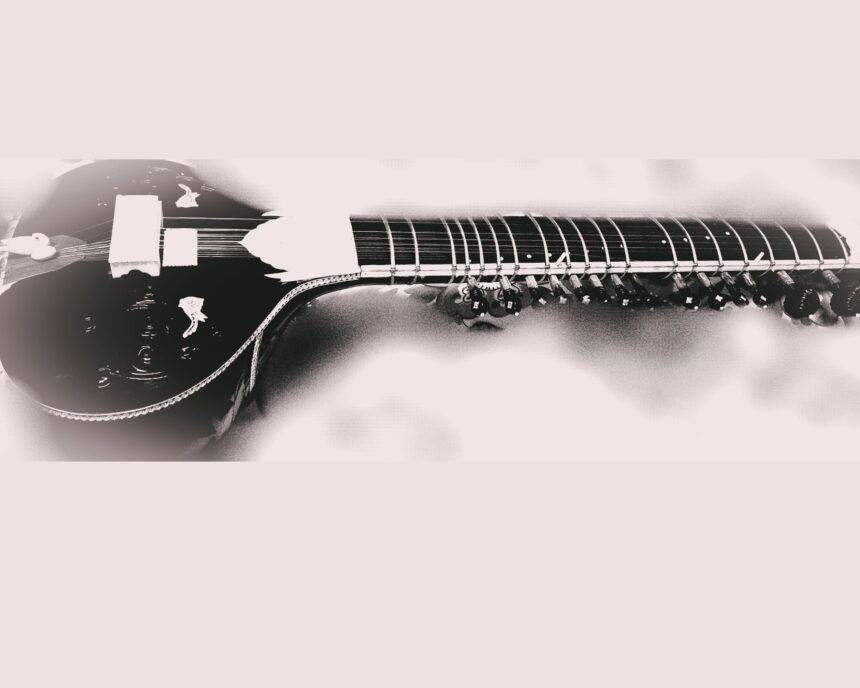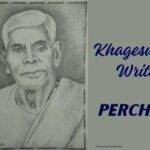Last Sunday evening was a distinctive moment for me as I had the privilege of attending the ‘Gharoa majlish’ organized by the SBSM of renowned sitar maestro and instructor Pandit Sanjoy Bandopadhyay. The term ‘Gharoa majlish’ holds significance for those with a bit of familiarity with the term ‘majlis.’ It essentially combines two words: ‘Gharoa,’ which implies ‘at home,’ and ‘Majlis,’ an Arabic term that translates to “sitting room.” To elaborate further, ‘majlis’ is a concept rooted in Arabic culture, often used to describe special gatherings or assemblies among individuals who share common interests. These gatherings can take various forms, be they administrative, social, or religious in nature. The term is particularly prevalent in regions with linguistic or cultural ties to Islamic traditions. The ‘Gharoa majlish’ organized by Pandit Sanjoy Bandopadhyay at the rooftop , represents a cultural convergence, bringing together individuals in a setting reminiscent of an intimate and welcoming space, much like a home, to partake in shared interests, discussions, or performances related to the artistry of the sitar. It encapsulates a blend of musical excellence, cultural understanding, and a sense of togetherness in a manner that resonates with the warmth and familiarity associated with being ‘at home.’
The rooftop venue featured a charmingly adorned small stage that beautifully captured the essence of a majlis setting. To my delight, I encountered a diverse audience, surprising me with the presence of individuals who were not directly connected to music either as practitioners or professionals but were genuine music enthusiasts. What struck me was the unique objective behind the event, as elucidated by Panditji himself. The primary aim of the event, according to Pandit Sanjoy Bandopadhyay, was to extend the reach of classical music beyond its traditional audience. It sought to engage and leave an impact on individuals who might not have a direct association with classical music but are avid lovers of the art form. The aesthetically pleasing stage on the rooftop served as a testament to this mission, creating an environment that resonated with the true spirit of a majlis.The gathering was not just about catering to classical music aficionados but also about introducing the genre to those uninitiated or less familiar with its intricacies. The event provided a platform for non-classical music listeners to experience and appreciate the nuances of classical compositions, observing firsthand the impact this rich musical tradition could have on their perceptions and preferences. The ‘Gharoa Majlish’ became a bridge, connecting classical music with a broader audience and fostering an exploration of how diverse individuals, regardless of their musical backgrounds, interpret and embrace this timeless art form.
The evening’s program unfolded with a meticulously planned lineup comprising three distinct performances. The inaugural act featured a captivating sitar performance by the talented Sri Samanway Sarkar. His skillful rendition on the sitar set the tone for an evening filled with melodic richness and artistic brilliance. Following this, the spotlight shifted to a solo tabla performance by Sri Indranil Mallick, who skillfully showcased the rhythmic intricacies and percussive brilliance of this traditional Indian percussion instrument. His solo tabla performance added a dynamic dimension to the musical journey of the evening. The climax of the event was marked by a soulful sarangi performance by the esteemed Ustad Allarakha Kalawant. The sarangi performance added a layer of depth and emotion to the overall musical experience. The synchronized interplay of these skilled artists created a harmonious tapestry of sound, showcasing the collaborative nature of classical Indian music. The performances were accompanied by equally adept musicians on tabla and harmonium, namely Sri Sohon Ghosh, Nabarun Kumar Dutta, and Subhasish Bhattacharya.

Each performance, with its unique charm and virtuosity, contributed to the diverse and immersive experience of the ‘Gharoa Majlish.’ The carefully curated lineup not only celebrated individual artistry but also highlighted the synergy that arises when talented musicians come together to create a collective musical masterpiece. The event unfolded as a testament to the richness and versatility of classical Indian music, leaving the audience enthralled and appreciative of the artistic expressions on display.
The event was marked by an engaging interaction between the artists and the audience, accompanied by the shared warmth of coffee. This concluding segment served as a unique bridge, fostering a meaningful connection between the performers and the audience. As the aroma of coffee permeated the air, it created an informal and relaxed atmosphere, breaking down the traditional barriers between the stage and the seating area. The artists, having showcased their musical brilliance, now engaged in conversations with the audience, sharing insights into their creative process, the historical context of the compositions, and even responding to queries from the attendees. This interactive session not only allowed the audience to gain a deeper understanding of the nuances of the performances but also provided a platform for the artists to connect on a more personal level. It became an opportunity for the audience to express their appreciation, ask questions, and share their reflections on the musical journey they had just experienced.
While the notion of “gharoa-majlis” may not be unfamiliar, particularly to the residents of Kolkata, the event’s revival in a fresh and innovative manner, infused with new philosophies, undoubtedly warrants admiration. As the organizer Panditji’s commitment to reimagining this cultural gathering reflects a forward-thinking approach. The familiarity of the concept within the city’s cultural landscape adds a layer of historical resonance, yet the event breathes new life in it with an infusion of novel perspectives and philosophies into the traditional framework of “gharoa-majlis,”. The event not only revitalized a cultural tradition but also set a precedent for creative and thoughtful reinterpretation.
We extend our sincere wishes for the sustained success of this reinvigorated concept. May it persist as a dynamic platform for cultural exchange, artistic exploration, and communal celebration, contributing to the vibrant cultural tapestry of Kolkata and beyond. The continued evolution of such initiatives ensures the preservation and evolution of cultural traditions, fostering a dynamic and thriving cultural scene for generations to come.






